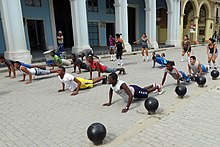Lack of physical education is the inadequacy of the provision and effectiveness of exercise and physical activity within modern education.[1]
When physical education fails to meet its goals of providing students with the knowledge base, life habits, and mindset necessary to be physically active throughout their lifetime,[2] it can lead children to adopt a sedentary lifestyle. According to a 2010 study by the WHO, 81% of children aged 11–17 worldwide did not meet the minimum recommended exercise guidelines of 60 minutes daily.[3]

Although more prevalent in countries of high income,[4] physical inactivity is an international issue that is correlated with an obesity epidemic[5] and negative physical,[6] psychological,[7] and academic consequences[8] in children.
A high quality physical education programs consists of these attributes:[9]
- Physical education teachers are certified
- Students in elementary school have physical education class for a minimum of 150 minutes per week, while students in high school have it for at least 225 minutes per week
- Concrete and achievable standards for students to meet (often for high school graduation)

- ^ Shannon W. Weed (2005), The disappearance of physical education
- ^ Sallis, James F (2012). "Physical Education's Role in Public Health: Steps Forward and Backward Over 20 Years and HOPE for the Future". Research Quarterly for Exercise and Sport.
- ^ "WHO | Prevalence of insufficient physical activity". www.who.int. Retrieved 2016-11-23.
- ^ Hallal, Pedro C; Andersen, Lars Bo; Bull, Fiona C; Guthold, Regina; Haskell, William; Ekelund, Ulf (2012-07-21). "Global physical activity levels: surveillance progress, pitfalls, and prospects". The Lancet. 380 (9838): 247–257. doi:10.1016/s0140-6736(12)60646-1. hdl:11250/170988. PMID 22818937. S2CID 8186207.
- ^ "Lack of exercise, not diet, linked to rise in obesity, Stanford research shows". News Center. 21 April 2013. Retrieved 2016-11-22.
- ^ Lee, I-Min; Shiroma, Eric J; Lobelo, Felipe; Puska, Pekka; Blair, Steven N; Katzmarzyk, Peter T (2012). "Effect of physical inactivity on major non-communicable diseases worldwide: an analysis of burden of disease and life expectancy". The Lancet. 380 (9838): 219–229. doi:10.1016/s0140-6736(12)61031-9. PMC 3645500. PMID 22818936.
- ^ Ploughman, Michelle (2008-01-01). "Exercise is brain food: The effects of physical activity on cognitive function". Developmental Neurorehabilitation. 11 (3): 236–240. doi:10.1080/17518420801997007. ISSN 1751-8423. PMID 18781504. S2CID 12656777.
- ^ Rasberry, Catherine N.; Lee, Sarah M.; Robin, Leah; Laris, B.A.; Russell, Lisa A.; Coyle, Karin K.; Nihiser, Allison J. (2011). "The association between school-based physical activity, including physical education, and academic performance: A systematic review of the literature". Preventive Medicine. 52: S10–S20. doi:10.1016/j.ypmed.2011.01.027. PMID 21291905.
- ^ "Approaches to Physical Education in Schools". Committee on Physical Activity and Physical Education in the School Environment. National Academies Press (US). 2013.
{{cite book}}:|website=ignored (help)